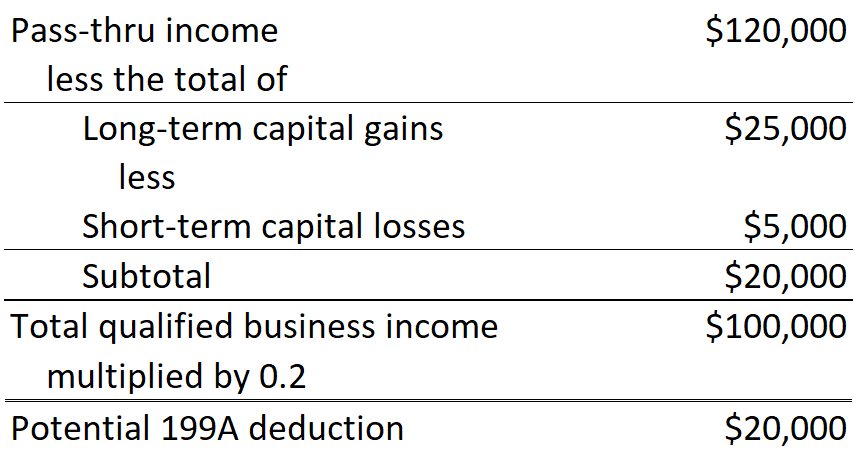One of the new aspects of the tax code is the 20% pass-thru deduction, also known as the 199A deduction. It is a centerpiece of the tax bill, and one which most small business owners have heard about. Nevertheless, it warrants detailed explanation because, unsurprisingly, it is more complex than it at first sounds.
This post covers the basics and will be followed by more posts that take a deeper dive into how the deduction changes as income rises.
But for now, we start with the simplest situation—one in which a taxpayer owns a pass-thru and has less than $315,000 of taxable income in a year (half of that amount for a single filer). This taxpayer will generally get to deduct 20% of their business income before calculating home much they owe in federal income tax. However, a few wrinkles make it more complicated in practice.
The new deduction is not based on business income as one generally thinks of it. Instead, it uses what the law calls “qualified business income” (QBI). But what exactly is QBI?
Qualified business income is equal to the income you derive from your interest in a pass-through business minus any “net capital gains.” For these purposes, “net capital gains” is defined as long-term capital gains (i.e. gain from the sale of stock owned for longer than one year) minus short-term capital losses (i.e. gain from the sale of stock owned for less than one year).
Take note that a taxpayer’s QBI does not include two common forms of pass-thru income. Both W-2 wages received from an S-corp as well as guaranteed payments received from a partnership are excluded from QBI.
Example:
Mike is married (and files jointly) and makes $120,000 in income from a pass-thru business, profits $25,000 from stock he has held for longer than a year, and takes a $5,000 loss from selling a stock he held for less than a year.

Thus, Mike would like to deduct $20,000 from his pre-tax income.
However, the law states that the maximum allowable deduction is the lesser of 20% of QBI or 20% of taxable income (without regard to the pass-thru deduction). To determine whether he can deduct the full $20,000, he must first calculate 20% of adjusted gross income minus deductions (standard or itemized).
In this case, Mike chooses to take the new standard deduction of $24,000, lowering his taxable income to $76,000. As 20% of $76,000 is $15,200, the maximum 199A deduction he may take is $15,200—nearly $5,000 less than 20% of his QBI.
An important aspect of the law that makes the deduction more widely available is that the income limits of $315,000 and $157,500 mentioned earlier are not based on adjusted gross income. Instead, they are based on taxable income (without regard to the pass-thru deduction).
Consider Joe, who has $400,000 in adjusted gross income—all of which comes from a pass-thru—no net capital gains, and has itemized deductions totaling $100,000. As his itemized deductions reduce his taxable income to $300,000—$15,000 below the income threshold—he is not restricted by the limits placed on the deduction for taxpayers above that limit.
This examples illustrates the basics of the new pass-through–or 199A–deduction, or what is known as the “199A deduction.” The next Tax Reform Toolkit post will explain what happens when a taxpayer’s taxable income exceeds the thresholds.
DISCLAIMER
This article is for informational purposes only. It should not be considered tax advice. Before making any tax decisions, work with a tax professional. For more detail, please see the full disclaimer.
Discover more from Eye On Housing
Subscribe to get the latest posts sent to your email.

I would be curious to see an example where there is a spouse with W-2 Income from an unrelated employer
Good info